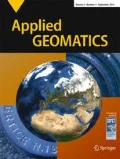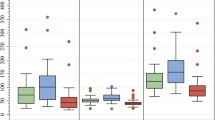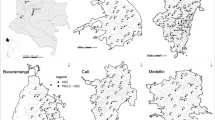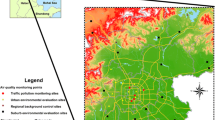Abstract
In Bangkok, nitrogen dioxide (NO2) concentrations have long been measured hourly by the Pollution Control Department (PCD) at 12 monitoring stations covering 430 km2 of Inner Bangkok. In the past, to estimate NO2 concentrations at any unmeasured location, the proximity model, interpolation model, or dispersion model was employed. These models used distance from a measured location as the sole determinant of any estimation. Toward the end of the 1990s, the more sophisticated land use regression (LUR) model was introduced. This model with its built-in geographic information system (GIS) and multiple regression analysis enabled the inclusion of other important determining variables such as land use types, traffic volume, and selected meteorological variables. This study aims to apply the LUR model for the estimation of NO2 concentrations over the study area covering Inner Bangkok. Monthly average NO2 concentrations, traffic volume, land use types, road areas together with humidity, temperature, wind speed, and rainfall data, measured at or within the vicinities of the 12 PCD stations, were input into the model. Only humidity, temperature, wind speed, rainfall, residential land use, and industrial land use were found to have influenced the NO2 concentrations in inner Bangkok. The resulting coefficient of determination (R squared) of 0.759 implies that 76 % of the variations in NO2 concentrations in inner Bangkok can be explained by the model. The study will, however, continue to obtain more precise traffic volume data in terms of time scale to improve the model.







Similar content being viewed by others
Referencess
Arain MA, Blair R, Finkelstein N, Brook JR, Sahsuvaroglu T, Beckerman B, Zhang L, Jerrett M (2007) The use of wind fields in a land use regression model to predict air pollution concentrations for health exposure studies. Atmos Environ 41:3453–3464
Beelen R, Hoek G, Pebesma E, Vienneau D, Hoogh KD, Briggs DJ (2009) Mapping of background air pollution at a fine spatial scale across the European Union. Sci Total Environ 407:1852–1867
Briggs DJ, Collins S, Elliott P, Fisher P, Kingham S, Lebret E, Pryl K, Reeuwijk HV, Smallbone K, Veen AVD (1997) Mapping urban air pollution using GIS: a regression-based approach. Int J Geogr Inf Sci 11(7):699–718
Exell RHB, Thavapalachandran S, Mukhia P (1981) The availability of wind energy in Thailand. AIT Res Rep 134
Gilbert N. L., M. S. Goldberg, B. Beckerman, J. R. Brook and M. Jerrett (2005). Assessing spatial variability of ambient nitrogen dioxide in Montreal, Canada, with a Land-Use Regression Model, Air & Waste Management Association 55: 1059–1063.
Hoek G, Beelen R, Hoogh KD, Vienneau D, Gulliver J, Fischer P, Briggs D (2008) A review of land-use regression models to assess spatial variation of outdoor air pollution. Atmos Environ 42:7561–7578
Jerrett M, Arain A, Kanaroglou P, Beckerman B, Potoglou D, Sahsuvaroglu T, Morrison J, Giovis C (2005) A review and evaluation of intraurban air pollution exposure models. J Expo Anal Environ Epidemiol 15:185–204
Leong ST, Laortanakul P (2003) monitoring framework for nitrogen dioxide measurement in a tropical city: a Bangkok case study. Environ Eng Sci 20:557–567
Office of Air and Radiation (2011) Air quality guide for nitrogen dioxide. U. S. E. P. Agency. www.airnow.gov, Office of Air and Radiation
Pangsang V (2004) Geographic Information System for determining air pollution risk area in the Bangkok Metropolis. Chulalongkorn University, Degree of Master of Arts in Geography
Panudulkitti P (2011) Evidence of urbanization on infrastructure and transportation provincial expenditures in Thailand. J Soc Transp Traffic Stud 2(2):6
Rosenlund M, Forastiere F, Stafoggia M, Porta D, Perucci M, Ranzi A, Nussio F, Perucci CA (2007) Comparison of regression models with land-use and emission data to predict the spatial distribution of traffic-related air pollution in Rome. J Exp Sci Environ Epidemiol:17
Su JG, Jerrett M, Beckerman B, Wilhelm M, Ghosh JK, Ritz B (2009) Predicting traffic-related air pollution in Los Angeles using a distance decay regression selection strategy. Environ Res 109:657–670
Acknowledgments
I would like to thank the Thailand Research Fund, the Office of Higher Education, and Chulalongkorn University for their financial support. I am particularly grateful for the assistance given by Associate Professor Pongsri Chanhow, my mentor. I also would like to express my appreciation to the Thai Meteorological Department, the Pollution Control Department, and the Ministry of Transport for the valuable digital data used in this study. Last but not least, I would like to thank Acharn William Whorton for his kindness for proof reading.
Author information
Authors and Affiliations
Corresponding author
Rights and permissions
About this article
Cite this article
Cheewinsiriwat, P. Estimation of nitrogen dioxide concentrations in Inner Bangkok using Land Use Regression modeling and GIS. Appl Geomat 8, 107–116 (2016). https://doi.org/10.1007/s12518-016-0170-y
Received:
Accepted:
Published:
Issue Date:
DOI: https://doi.org/10.1007/s12518-016-0170-y




